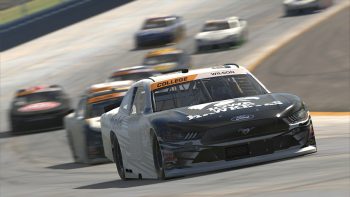
Grassy Know
February 6th, 2010 by DavidP
We may argue for centuries about who killed JFK, but if there was someone suspicious on the grassy knoll, I can guess he didn’t make his getaway in a car with lots of torque. Given my online racing experience with iRacing, he likely would have been another easy target for Jack Ruby since he’d be spinning his wheels on the grass while the car was stationary.
I remember cursing the slippery grass at various tracks and praying for the wizards at iRacing to “fix” it. After all, going off track at high speed at a place like VIR with wide fields next to the track means you could be in for a long excursion before you can collect your bearings (in every sense of the word), and turn on the GPS to figure out how to get back to the track. Surely it couldn’t be. In the end, I just used extra caution in those parts of the track to ensure I kept the rubber on the road.

Let's not distort the facts . . .
But on occasions where I would misjudge the exit of a turn and touch the grass, I was in for a nasty spin with all the foul language that accompanies it. So after about 500 such spins, and taking into account Einstein’s definition of insanity, I decided to alter my driving technique: when I would see the edge of the road getting unavoidably close, I eased-off the throttle.
Yes! With this freshly patented move (I’m sure no-one has ever attempted this) of just easing-off the throttle, one of two fortuitous things happen. Either the car makes the corner and avoids going off the edge of the track due to the induced oversteer, or when the car could not be saved from “going agricultural,” it no longer spun out of control; and with some creative use of the steering wheel I quickly regained my path to the theater.
But in spite of my evolving driving genius I still believed the folks at iRacing were out in left field when it comes to grass physics. So I decided to put it to the test. I took the Daytona Prototype to – where else? – Daytona International Speedway and went for a wee spin in the grass. Actually, I went as fast as I could over the Daytona logo field in a makeshift grass skidpad to see how fast I could go without losing grip in a tight radius (~25m). Telemetry measured the lateral acceleration at about 0.70 Gs. Then I did similar radius circles on the adjacent asphalt and got upwards of about 1.5 Gs or so. Hmmm. The grass felt like I was driving on ice, but it wasn’t a conspiracy, because 0.7 Gs is actually not bad grip. Just under half of what I was getting on the track. I found the same results with accelerating and braking in a straight line.
Daytona International Speedway, aka, Ray's personal grass skidpad.
Then I Googled ‘tire friction grass’ and was shocked to find that, sure enough, street tires have a friction coefficient on dry grass of about 0.35 compared to asphalt at about 0.72. Racing tires have special compounds to bring the friction coefficient on the track up to 1.8, but there is no data on racing tires in grass. Assuming the ratio of grip on asphalt and grass is similar for racing tires, then iRacing have gotten it almost exactly right with the ratio of grip on tarmac compared to grass. If, however, the racing tires maintain the same grip as street tires on grass at about 0.35, then actually we have three times as much grip as we should on grass! I think the former assumption is closer to the truth, and actually now have to admit I was in error about my former grass = ice assertions. In fact, tires on ice have a friction coefficient between 0 and 0.1, so the grass probably has at least 4 times the grip of ice.
So no need to get upset about the sim accuracy. In fact, my donuts in the Daytona grass made me think I may have a future in Oval racing after all. I just have to remember how the steering wheel goes: “Back, and to the left…. Back, and to the left…. Back, and to the left….”















































